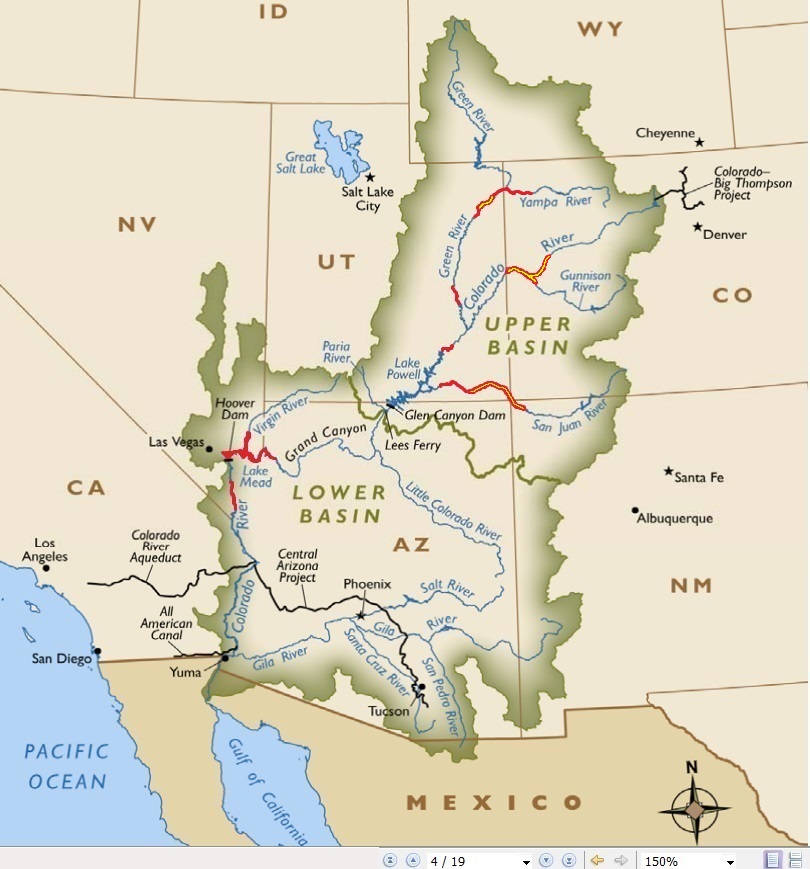Difference between revisions of "GCDAMP RAZU Fish"
Cellsworth (Talk | contribs) |
Cellsworth (Talk | contribs) |
||
| Line 59: | Line 59: | ||
**The last one recorded had been caught in 1990. | **The last one recorded had been caught in 1990. | ||
**Caught October 9th, lower part of Grand Canyon believed to have traveled upstream some 50 miles from Lake Mead. | **Caught October 9th, lower part of Grand Canyon believed to have traveled upstream some 50 miles from Lake Mead. | ||
| − | |||
| − | |||
| − | |||
| − | |||
| − | |||
| − | |||
| − | |||
| − | |||
| − | |||
| − | |||
| − | |||
[http://www.coloradoriverrecovery.org/general-information/the-fish/razorback-sucker.html '''Status and distribution'''] | [http://www.coloradoriverrecovery.org/general-information/the-fish/razorback-sucker.html '''Status and distribution'''] | ||
| Line 107: | Line 96: | ||
*Other identifiable threats that could significantly affect the population are removed. | *Other identifiable threats that could significantly affect the population are removed. | ||
| + | |} | ||
| + | <!-- | ||
| − | |- | + | ---- |
| − | ! <h2 style="margin:0; background:#cedff2; font-size:120%; font-weight:bold; border:1px solid #a3b0bf; text-align:left; color:#000; padding:0.2em 0.4em;">Reports and Links </h2> | + | --------------------------------ADDITIONAL-------------------------------> |
| + | |class="MainPageBG" style="width:45%; border:1px solid #cedff2; background:#f5faff; vertical-align:top;"| | ||
| + | {| width="100%" cellpadding="2" cellspacing="5" style="vertical-align:top; background:#f5faff;" | ||
| + | ! <h2 style="margin:0; background:#cedff2; font-size:120%; font-weight:bold; border:1px solid #a3b0bf; text-align:left; color:#000; padding:0.2em 0.4em;">Reports and Links</h2> | ||
|- | |- | ||
|style="color:#000;"| | |style="color:#000;"| | ||
| Line 123: | Line 117: | ||
*[http://www.usbr.gov/uc/rm/amp/twg/mtgs/14jan30/AR_Healy_NF&RBS.pdf Native Fish Population Trends – Grand Canyon Tributaries Razorback Sucker: Status and Habitat Use (Healy)] | *[http://www.usbr.gov/uc/rm/amp/twg/mtgs/14jan30/AR_Healy_NF&RBS.pdf Native Fish Population Trends – Grand Canyon Tributaries Razorback Sucker: Status and Habitat Use (Healy)] | ||
| + | |- | ||
| + | ! <h2 style="margin:0; background:#cedff2; font-size:120%; font-weight:bold; border:1px solid #a3b0bf; text-align:left; color:#000; padding:0.2em 0.4em;"> LTEMP BiOp Conservation Measures for Razorback Sucker [https://www.fws.gov/southwest/es/arizona/Documents/Biol_Opin/120059_LTEMP%20BiOp_11-25-16.pdf] (2016) </h2> | ||
| + | |- | ||
| + | |style="color:#000;"| | ||
| + | |||
| + | Ongoing actions: | ||
| + | |||
| + | Reclamation would continue to assist the NPS, FWS, and the GCDAMP in funding '''larval and small-bodied fish monitoring''' in order to: | ||
| + | |||
| + | *Determine the extent of hybridization in flannelmouth and razorback sucker collected in the western Grand Canyon. | ||
| + | |||
| + | *Determine habitat use and distribution of different life stages of razorback sucker to assist in future management of flows that may help conserve the species. Sensitive habitats to flow fluctuations could be identified and prioritized for monitoring. | ||
| + | |||
| + | *Assess the effects of TMFs and other dam operations on razorback sucker. | ||
|- | |- | ||
Revision as of 15:43, 21 March 2017
|
|
Razorback sucker (Xyrauchen texanus)Three to 5 million years ago, a unique-looking fish with a sharp-edged hump “razorback” behind its head swam the Colorado River and its tributaries. The razorback sucker is an endangered, native fish of the Colorado River and the only member of the genus Xyrauchen. It has a dark, brownish-green upper body with a yellow to white-colored belly and an abrupt, bony hump on its back shaped like an upside-down boat keel. One of the largest suckers in North America, the razorback sucker can grow to 3 feet in length and can live for more than 40 years. Razorback sucker can reproduce at 3 to 4 years of age. Depending on water temperature, spawning can occur as early as November or as late as June. In the Upper Colorado River Basin razorback sucker typically spawn between mid-April and mid-June. Razorback sucker eat insects, plankton, and plant matter on the bottom of the river. To complete its life cycle, the razorback sucker moves between adult, spawning, and nursery habitats. Spawning occurs during high spring flows when razorback sucker migrate to cobble bars to lay their eggs. Larvae drift from the spawning areas and enter backwaters or floodplain wetlands that provide a nursery environment with quiet, warm, and shallow water. Research shows that young razorback sucker can remain in floodplain wetlands where they grow to adult size. As they mature, razorback sucker leave the wetlands in search of deep eddies and backwaters where they remain relatively sedentary, staying mostly in quiet water near the shore. In the spring, razorback sucker return to the spawning bar, often quite a long distance away, to begin the life cycle again.
|
| Online training |
Fish Species of the Colorado River in Lower Glen Canyon and Grand Canyon |
Fish photos, information, and maps |
|---|
|
|
